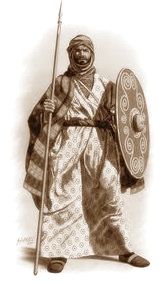
Battle of Iron Bridge(Antioch) |
year: 637October 637 |
| Victory of the Arabs and loss of Antioch | ★ ★ ★ ★ ★ |
|
enemy: Arabs
|
location: Around 20 km from Antioch, near Syrian-Turkish borders
|
accuracy:
●●●●●
|
|
battle type: Pitched Battle |
war: Arab Conquest of Syria |
modern country:
Syria |
| ▼ The Byzantines(emperor: Heraclius) | ▼ The Enemies | |
| Commander: | Unknown | Abu Ubaidah & Khalid ibn al-Walid |
| Forces: | 15,000-20,000 | 17,000 |
| Losses: | 10,000 | Low |
| Background story: |
| The Muslim army captured Damascus (635) and Jerusalem (637), and marched northward conquering more parts of the Levant. They penetrated into Anatolia intending to capture Antioch , the capital of the Asian part of the Byzantine empire. After the conquest Aleppo, the Muslim commander-in-chief Abu Ubaidah ibn al-Jarrah sent a column to capture Azaz another important stronghold in southern Anatolia, east of the Taurus Mountains. After the success of this mission, the Arabs moved westwards to capture Antioch, with Khalid ibn Walid leading the campaign with his Mobile guard. |
The Battle: |
 The Byzantine forces suffered heavy losses and were defeated. Their casualties in this battle were the highest in the Muslim conquest of Syria, with the exceptions of the decisive battles of Ajnadayn and Yarmuk. The remnants of the Byzantine army fled to Antioch. The Arabian army moved up and laid siege to Antioch. The city surrendered a few days later, on October 30, 637. According to the pact, the defeated Byzantine soldiers were allowed to depart in peace. |
Aftermath: |
| The immediate effect of the defeat was the loss of Antioch, one of the most important Byzantine cities in the East. The cities of Latakia, Jablah (Gavala) and Tartus followed. The Taurus mountains became the westernmost frontier of the Rashidun Caliphate. |
|
|
